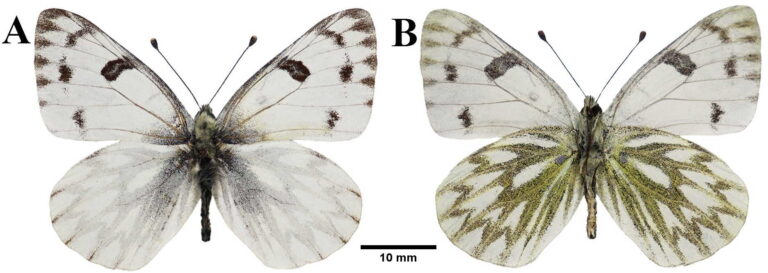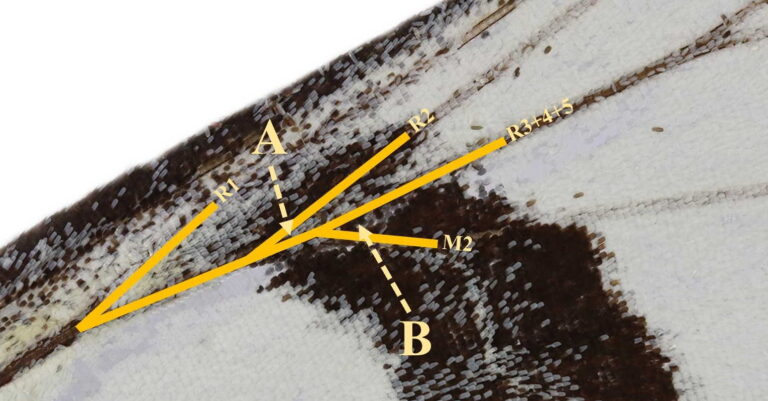
Four species of the pierid genus Pontia, commonly referred to as whites, are present in North America, mostly distributed towards the western part of the continent. With ongoing global climate change, many lepidopteran groups, including Pontia, are expected to shift their distribution northward or modify their migratory patterns. For instance, in certain Canadian provinces, colonies of Pontia protodice (Boisduval & Leconte) can persist for several years before being extinguished, but they are expected to establish permanently under a warming climate (Pohl et al. 2018).
Due to the isolation of northern regions and the limited availability of research specimens, the documentation of species in northern regions has been underrepresented over the past 45 years (Pohl et al. 2019). The current note reports the recent discovery of seven specimens of Pontia occidentalis (Reakirt, 1866) sensu Chang (1963), at the mouth of the Rupert River in Eeyou Istchee James Bay, near the village of Waskaganish, Quebec, Canada. While these records are not surprising given the current species biogeography, they represent the first record for the genus Pontia in the province of Quebec since 1921. These findings contribute to the baseline data, enhancing our understanding of the Lepidofauna of the northern regions.
Pontia protodice is currently the only species of Pontia in North America closely resembling P. occidentalis. Pontia protodice is a permanent resident in the southern United States and a temporary resident in the northern United States and southern Canada (Opler & Wright 1999). In Canada, the species currently ranges from British Colombia to Ontario, with only one record in Quebec dating back to 1921 in Montreal, and one other record in Newfoundland and Labrador in 2001 (GBIF.org 2024). The color and patterns of P. protodice and P. occidentalis are commonly indistinguishable (Chang 1963). According to Chang (1963), the two primary criteria for distinguishing the two species are the width of the tornus dot and the location of the R2 veins in relation to the M2 veins. In P. protodice males, the dot in the tornus area near the inner margin of the underside of the forewings is often large, square shaped and not clearly outlined, with part of the dot sometimes submerged on the upper sides. In P. occidentalis males, the dot is often small, clearly outlined and not submerged. Regarding the venation, in P. protodice, the intersection between R2 and Rs + M1 (“A” on Fig. 2) is usually above point “B”, where M2 joins the vein. In P. occidentalis, point “A” is usually on or before point “B” (Fig. 3).
The distribution of P. occidentalis ranges from Alaska to Ontario (Hall et al. 2014; Pohl et al. 2018) and the species is also commonly found in the western United States (GBIF.org 2024). Its larval hosts are similar to those of P. protodice, feeding mostly on Brassicaceae (Robinson et al. 2023). Contrary to P. protodice, P. occidentalis is considered a non-migrant species. This suggests that the specimens sampled in Eeyou Istchee James Bay may not necessarily originate from a recent colonization, as the species is considered common at Netitishi Point in Ontario, which is approximately 100 km in a straight line from the Quebec sampling site (GBIF.org 2024). The species has probably been long-established in the region. The recent discovery of specimens as a first record of the species in the province of Quebec is likely due to the scarce surveying of the butterfly communities of the region in late summer. These findings highlight the necessity for a more comprehensive assessment of northern lepidopteran communities.
I thank Karl Roberge (Saint-Félicien, QC) for allowing the use of his specimen records. I also thank Norbert Kondla (Calgary, AB) for his valuable insights regarding Pontia, as well as Tonia De Bellis (Dawson College, Montreal, QC) and Felix Sperling (University of Alberta, Edmonton, AB) for their comments on the manuscript.
Chang, V.C.S. 1963. Quantitative analysis of certain wing and genitalia characters of Pieris in western North America. Journal of Research on the Lepidoptera, 2(2): 97-125.
GBIF.org. 2024. GBIF Occurrence Download. https://doi.org/10.15468/dl.d6ah6r, retrieved 2024-01-01.
Hall, P.W., C.D. Jones, A. Guidotti and B. Hubley. 2014. The ROM Field Guide to Butterflies of Ontario. Royal Ontario Museum, Toronto, Ontario. 464 pp.
Opler, P.A. and A.B. Wright. 1999. Peterson field guide to western butterflies. Houghton Mifflin Company, Boston, Massachusetts. 540 pp.
Pelham, J.P. 2008. A catalogue of the butterflies of the United States and Canada with a complete bibliography of the descriptive and systematic literature. Journal of Research on the Lepidoptera, 40: 1-658.
Pohl, G.R., B.C. Schmidt and J.R. deWaard. 2019. Lepidoptera of Canada. ZooKeys: 819: 463-505. https://doi.org/10.3897/zookeys.819.27259
Pohl, G.R., J.F. Landry, B.C. Schmidt, J.D. Lafontaine, J.T. Troubridge, A.D. Macaulay, E.J. van Nieukerken, J.R. deWaard, J.J. Dombroskie, J. Klymko, V. Nazari and K. Stead. 2018. Annotated checklist of the moths and butterflies of Canada and Alaska. Pensoft Publishers, Sofia, Bulgaria. 580 pp.
Reakirt, T. 1866. Descriptions of some new species of diurnal Lepidoptera. Proceedings of the Academy of Natural Sciences of Philadelphia, 18: 238-249. https://www.biodiversitylibrary.org/page/26374958
Robinson, G.S., P.R. Ackery, I. Kitching, G.W. Beccaloni and L.M. Hernández. 2023. HOSTS – a Database of the World's Lepidopteran Hostplants [Data set]. Natural History Museum, London. https://data.nhm.ac.uk/dataset/hosts accessed 2024-01-28.

Fig. 1. (A) Dorsal and (B) ventral view of a male Pontia occidentalis sampled in Eeyou Itschee James Bay, Quebec, specimen KRC-PPO-003.

Fig. 2. Illustration of differences in dorsal anterior wing venation between Pontia protodice and Pontia occidentalis adapted from Chang (1963). In P. protodice, intersection between R2 and Rs + M1 (A) is usually above (B) where M2 joins the vein. In P. occidentalis, (A) is usually on or before (B).

Fig. 3. Dorsal anterior wing venation of a Pontia occidentalis male, specimen KRC-PPO-003, as illustrated in Fig. 2.